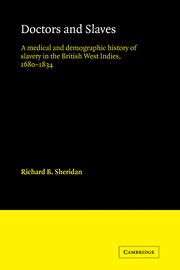 Doctors and Slaves
Doctors and Slaves Book contents
- Frontmatter
- Contents
- List of tables and figures
- Preface
- Acknowledgment
- 1 The disease environments and epidemiology
- 2 The medical profession
- 3 African and Afro-West Indian medicine
- 4 The Guinea surgeons
- 5 Slaves and plantations
- 6 Labor, diet, and punishment
- 7 Morbidity and mortality
- 8 The problem of reproduction
- 9 Smallpox and slavery
- 10 Slave hospitals
- 11 Plantation medical practice
- 12 Slavery and medicine
- Notes
- Bibliography
- Index
3 - African and Afro-West Indian medicine
Published online by Cambridge University Press: 04 August 2010
- Frontmatter
- Contents
- List of tables and figures
- Preface
- Acknowledgment
- 1 The disease environments and epidemiology
- 2 The medical profession
- 3 African and Afro-West Indian medicine
- 4 The Guinea surgeons
- 5 Slaves and plantations
- 6 Labor, diet, and punishment
- 7 Morbidity and mortality
- 8 The problem of reproduction
- 9 Smallpox and slavery
- 10 Slave hospitals
- 11 Plantation medical practice
- 12 Slavery and medicine
- Notes
- Bibliography
- Index
Summary
I had intended to have given you some account of the medical plants of this island [Jamaica], especially of those whose medical properties are known to the negroes; but I find it would be impossible to enumerate them even in any reasonable limits. I am, however, so thoroughly persuaded that a variety of very valuable plants are known to the negroes, whose medical uses we are unacquainted with, that I think any person who would undertake an account of the popular medicine of the negroes, would bring to light much information serviceable to medical science.
R. R. Madden, M.D., 1835In this chapter we examine the medical culture of West Africa, the extent to which it was carried by the slaves to the West Indian colonies, and how it was modified and, in part, suppressed when it came into contact with the white medical establishment on sugar plantations. Separate sections focus on the treatment of yaws, the slave medical attendants on plantations, and the role of women in Afro-West Indian medicine.
The two medical cultures: Africa
Two medical cultures – one African, one European – have dominated the British Caribbean territories during the past three centuries. African medicine, which combined mystical beliefs and rituals with herbal remedies and poisonous substances, was brought to the New World by the slaves. Telling the story of African folk medicine in the colonies is difficult. White colonials were so convinced of their cultural superiority that they dismissed African medicine or “white magic” as mere superstition.
- Type
- Chapter
- Information
- Doctors and SlavesA Medical and Demographic History of Slavery in the British West Indies, 1680–1834, pp. 72 - 97Publisher: Cambridge University PressPrint publication year: 1985


